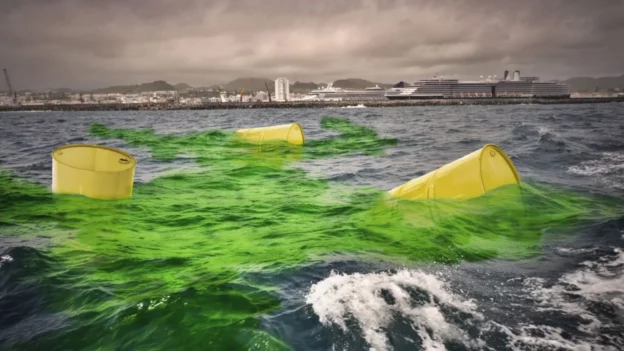The United Kingdom has announced a plan to develop an underwater nuclear cemetery and bury old nuclear waste . This project aims to house this dangerous waste in vast underground caverns, located in the country’s deep sea.
An underwater cemetery to bury nuclear waste
The project design foresees the excavation of approximately 36 km² in tunnels in rock formations, thus creating the necessary space to deposit the waste accumulated during seven decades of civil nuclear energy production.
The completion of this project would require more than a century and a half, at a cost estimated at 66 billion pounds, according to Nuclear Waste Services ( NWS ). NWS scientific advisor Neil Hyatt explained: ” After 70 years of nuclear activity, mainly civil, but also industrial and defence, we are faced with a considerable volume of waste, estimated at 750,000 m 3 “. This infrastructure must be designed to contain more than 110,000 tons of uranium, 6,000 tons of used nuclear fuel and nearly 120 tons of plutonium.
Although the exact site for the future Geological Disposal Facility ( GDF ) has not been finalised, there are two locations that are being considered: the first is on the Lincolnshire coast, near Mablethorpe and the next on the Cumbrian coast, near by Copeland . The plan details the construction of a deep shaft into the earth, followed by the excavation of horizontal tunnels under the seabed. Once ready, large vaults will be created in impermeable clays and shales, creating chambers sealed with cement, ready for storage.
Search for permanent solutions
The lethal nature of radioactive waste, which will remain active for millennia, has forced the UK to consider permanent solutions. The initial cost of the project was underestimated by more than $14 billion , but after the construction of the Hinkley Point C nuclear power plant in 2017, estimates increased to $53 billion. With an additional inflation of 26%, costs would eventually rise to the aforementioned 66 billion, covering both construction and operating expenses for 150 years.
According to Steve Thomas, professor of energy policy at the University of Greenwich, building a GDF of this magnitude is an unprecedented challenge : “Something like this has never been attempted so many meters under the sea. Mobilizing that amount of rock is a colossal undertaking“. This problem has revived debates about nuclear waste management in the country. A 1976 report from the Royal Commission into Environmental Pollution warned of the rapid accumulation of this waste and recommended pausing the construction of new nuclear reactors until a viable solution was found.
Despite the challenges, in 1982 Nirex was established to explore possible locations for geological deposits. However, after 25 years without finding a solution, Nirex merged with the Nuclear Decommissioning Authority ( NDA ), culminating in the launch of the current project.
Despite support from experts such as Tom Greatrex, chief executive of the Nuclear Industry Association, who claims that geological disposal is the safest strategy for the disposal of high-level waste, local communities, particularly in Mablethorpe and Cumbria, They have expressed their opposition through protests and petitions, calling the proposed sites inadequate.
Follow us on social networks and don’t miss any of our publications!
Inspenet.com YouTube LinkedIn Facebook Instagram X
Source: Nuclear Waste Services
Photo: Shutterstock


